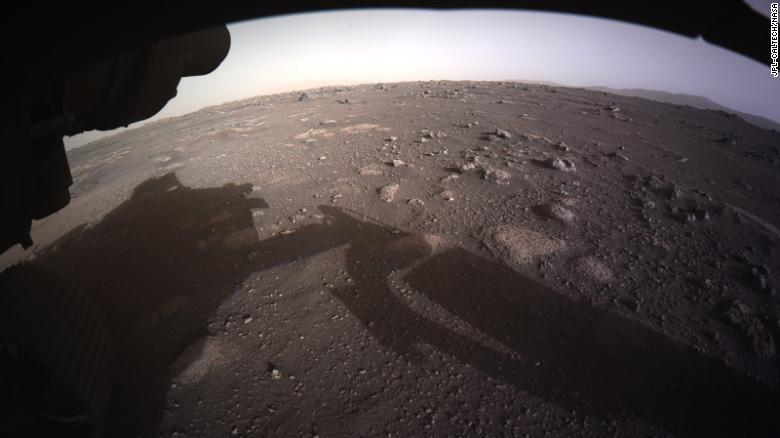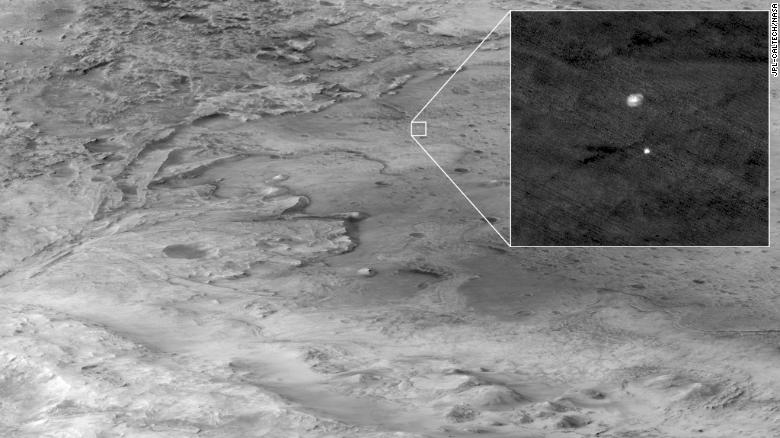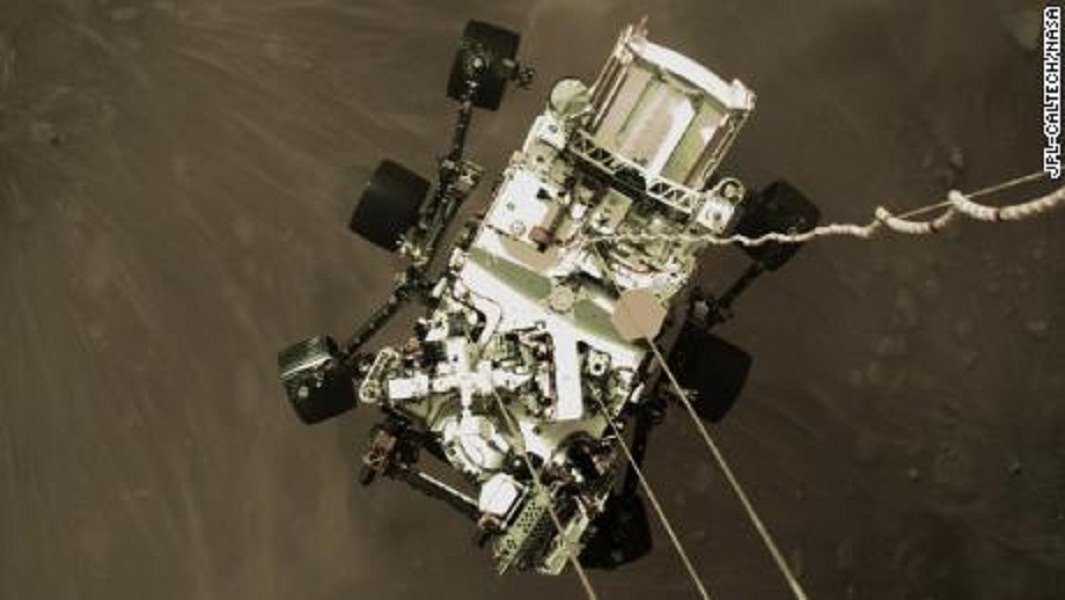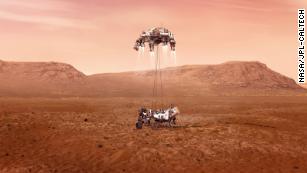Incredible new images shared by Perseverance rover after Mars landing
After safely landing on the surface of Mars Thursday, NASA's Perseverance rover has sent back a never-before-seen view: what it looks like to land on Mars.
The rover also returned some beautiful postcards of its landing site.
The first image shared during a NASA press conference Friday was "exhilarating" for the team when they received it. It shows the rover nearing the Martian surface during entry, descent and landing. A camera on the descent stage of the spacecraft captured the perspective, something that wasn't possible on previous missions.
"This shot from a camera on my 'jetpack' captures me in midair, just before my wheels touched down," according to a tweet from the Perseverance Twitter account. "The moment that my team dreamed of for years, now a reality. Dare mighty things."

This shot from a camera on Perservance's "jetpack" captures the rover in midair, just before its wheels touched down.
Little dust plumes can be seen kicking up from the Martian surface, stirred by the engines landing the rover when it was just 6.5 feet above the surface.
"The team is overwhelmed with excitement and joy to have successfully landed another rover on the surface of Mars," said Adam Steltzner, the rover's chief engineer. "When we do such investments, we do them for humanity, and we do them as a gesture of our humanity."
The joy of celebrating a rover landing on Mars
Steltzner cited iconic space images from the Apollo mission, like Buzz Aldrin on the surface of the moon, Voyager's first image of Saturn and the Hubble Space Telescope's awe-inspiring "Pillars of Creation" photo.
"We can only hope, in our efforts to engineer spacecraft and explore our solar system, that we might be able contribute yet another iconic image to this collection, and I'm happy to say that I'm hopeful that today we can with this."
While the first images returned by the rover Thursday evening were black and white glimpses showing it safely landed on Mars, color images made available Friday show the characteristic red color of the Martian surface.

This is the first color image released from Perseverance on the Martian surface.
"An open horizon, with so much to explore. Can't wait to get going," the Perseverance account tweeted.
Rocks are also seen scattered across the flat surface of the landing site in Jezero Crater, but they're small when compared to the large rover wheels.

Rocks spotted by the rover have holes in them -- which has the scientists curious to see what would cause them.
Another tweet with the image read, "I love rocks. Look at these right next to my wheel. Are they volcanic or sedimentary? What story do they tell? Can't wait to find out."
The Mars Reconnaissance Orbiter's HiRISE camera, which flew over the landing site as Perseverance was coming in for a landing, captured an incredible view as the spacecraft's parachutes opened.

HiRISE captured this image of Perseverance on its way to the landing site.
"The Beauty of Flight! HiRISE captured this image of @NASAPersevere on its way to the landing site from over 700 km (435 mi) away!" the HiRISE account tweeted.
"If you look below to the little circle, this was our eventual touchdown point," said Aaron Stehura, deputy phase lead for entry, descent and landing. "You can see it's near the river delta that we've talked about."
Stehura also reflected on the moment the team saw the image of the rover from the perspective of the descent stage.
"This is something that we've never seen before. It was stunning and the team was awestruck. And, you know, there's just a feeling of victory that we're able to capture these and share them with the world."
The teams also shared a little insight about how they celebrated after the landing. Some members of the team enjoyed some ice cream at safe social distances outside, many virtual parties were enjoyed and team members slept the best they have in a long time, knowing Perseverance was safe.
What's next for the rover
"The rover is doing great and is healthy on the surface of Mars and continues to be highly functional and awesome," said Pauline Hwang, strategic mission manager for the rover.
This weekend, the rover will go through some hardware checkouts to make sure everything is working properly, she said. The head, or mast, will unfold and cameras on the mast will capture more images of the rover's surroundings to provide a panorama, as well as a "selfie" panorama of the rover.
Ingenuity, the little helicopter tucked up under the rover, will also go through a checkup. Before the helicopter can begin its series of test flights over a 30-day period, a lot has to happen and it will take time, Hwang said.
Perseverance rover has successfully landed on Mars and sent back its first images
The rover will need to drive to a location, called the helipad location, where it can drop the helicopter on the surface of Mars and roll back away from the helicopter. Perseverance will be able to watch and record images and video of these historic flights. Ingenuity also carries two cameras and will be able to share its aerial views.
Now that the rover has landed, it can switch over to the software it will need to use while driving on the Martian surface.
The images sent back by the rover will inform the science team "so that we can actually begin to really start the mission," said Hallie Gengl Abarca, the rover's imaging and data processing team lead for surface operations.
Katie Stack Morgan, deputy project scientist for the rover, has been helping to lead a team of 450 scientists around the world as they prepare to explore Jezero Crater. Now, they're ready to study these images and plot out a path for the rover to use as it navigates intriguing features of the crater.
Perseverance landed about 1.2 miles away from the river delta feature within Jezero Crater, which hosted a lake 3.9 billion years ago. The rover will spend the next two years investigating the crater and delta in the search for evidence of ancient life that may have existed when Mars was a more habitable place.
The rover will explore nearby rocks on the crater floor to determine if they are volcanic basalt or sedimentary rocks and investigate the presence of a mineral called olivine, Morgan said.
Ingenuity will be the first helicopter to fly on Mars
"That's a mineral that is very interesting to us, and thoughts are that this could be an explosive ash deposit deposit into Jezero Crater," she said. "On the other hand, we are in a lake basin and these could be lake sediments that we're seeing."
Holes present in some the rocks visible in images taken by the rover could suggest either gas that escaped the rocks if they were formed from lava, or fluids that dissolved part of the rock if they're sedimentary.
"Between us and the delta, we have a lot of interesting science to do," she said. "As soon as we got that color image from the surface of Mars, our chats lit up with the science team saying 'look over here' and' look over here.' And that's exactly what we were hoping for it and we can't believe that we're really doing science now on the surface of Mars."
News Courtesy:
https://edition.cnn.com/2021/02/19/world/mars-rover-new-images-scn-trnd/index.html














